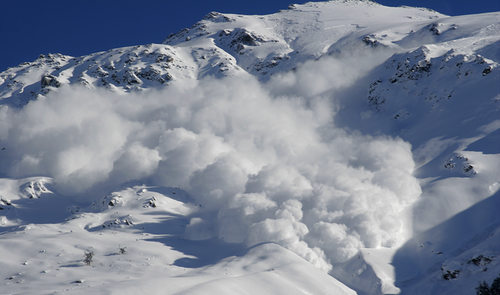Precursor Sounds Warn of Imminent Slip
Pushing a cinder block across the floor may involve a series of stops and starts, or “stick-slip” transitions, similar to the process that causes earthquakes as tectonic plates slide past one another. Now researchers studying how sticking gives way to slipping have shown that the crucial moment of slip can be predicted, at least roughly, by recording sound emitted at the interface. The finding may help researchers foresee impending failures in systems ranging from ridges of gravel or sand to mountains containing dormant volcanoes.
Researchers suspect that general principles may apply to all stick-slip transitions. One prominent idea, suggested by experiments with idealized granular solids made of many plastic beads pressed together, is that a stressed material approaching the moment of slipping tends to become less than perfectly rigid. Long-wavelength acoustic waves begin to propagate as a result of motions of the particles at the microscale, although the waves may be far from obvious at large scales.
Karen Daniels of North Carolina State University in Raleigh, along with graduate student Eli Owens, previously detected these pre-slip waves in a two-dimensional material by sending in sound waves and recording the emitted sounds. More recently, she and NC State colleague Ted Brzinski III wondered if they could detect the approach to slipping in a noninvasive way, by simply listening for the sounds the pre-slip motions generate.
The researchers experimented with a solid material represented by a single layer of 8000 tiny plastic disks trapped in the annular space between inner and outer walls with radii of about 30 and 67 cm. They applied a shear stress to the material by slowly rotating the inner wall, so that it completed one rotation per hour. Friction forces between the moving inner wall and the disks tended to distort the material, while friction between the particles resisted any motion. Monitoring the behavior of the disks for 23 hours, the researchers observed a pattern of repeated stick-slip motion. The particles would lock in place for a time, typically about 60 seconds, before the twisting force grew large enough to drive a slipping event, with disks suddenly rearranging into a new position within a half second or so.
During the experiment, Brzinski and Daniels used 12 sensors embedded in the outer wall to record vibrations emitted by the disk system. They found that the vibrations evolved as the solid approached the moment of slip, with an ever growing range of vibrational wavelengths, especially longer wavelengths. The researchers say that this vibrational behavior agrees with other, less direct observations of the pathway to slipping.
The experiments also demonstrate a more practical way to monitor this change compared with the team’s previous work, where an input sound wave was required. “We wanted to make the technique diagnostic, where we would just passively listen,” says Daniels. “We knew there should be information in the noise, and we've been able to show that.”
“This is important work,” says soft matter physicist Lisa Manning of Syracuse University, New York. “It suggests a new method for assessing the internal state of granular packing and shows that the vibrations inside change a lot when the material gets close to failing.” She adds that the new insight could be used to predict failure in a wide range of materials.
The experiments suggest an approach to monitoring the risks of avalanches, landslides, or volcanic eruptions. As the researchers stress, however, the method won't be able to predict events precisely in time but may be useful in probabilistic forecasting and identifying time periods when an event is more likely. Brzinski and Daniels also suggest applying the method to predicting earthquakes, although that remains a long way off. In the near future, they intend to work with collaborators in testing the idea on seismic data.
This research is published in Physical Review Letters.
–Mark Buchanan
Mark Buchanan is a freelance science writer who splits his time between Abergavenny, UK, and Notre Dame de Courson, France.





